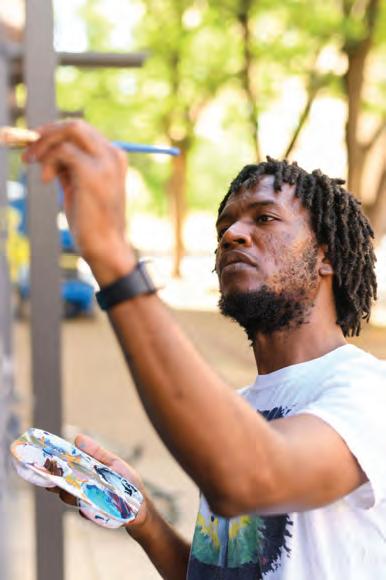
24 minute read
Why The Arts Matter
FOCUS Why The Arts Matter
In 100 words or less, following is what this month’s collection of guest contributors had to say:
I have been involved with art for 40+ years as a weaver and the owner of the Blue Streak Gallery. Art can communicate, inspire, motivate, and educate! It is almost as important as food, shelter, and air as it makes life worth living and delights the soul.
On a trip to Bali, I learned there is no word for “artist” because everyone is an artist in some way! I hang artworks in my gallery and in places people eat, recreate, live and exercise to encourage them to view art in their daily activities.
Be courageous and create something.”
— Ellen Bartholomaus, Artist & Owner of Blue Streak Gallery, Trolley Square (Wilm.)
As I walk tree-lined streets and city blocks with beautiful exteriors of storefronts and sit in the park watching the sun rise — I see ART everywhere! Art tells stories, art allows us to express who we are and what we love. Art is everything from music, style of dress, pictures hanging on a wall, to the tone in which we speak to someone. We couldn’t exist in this world without art. The Arts matter, the Arts lift spirits, they help to break barriers of social injustices, brings forth unity, and creates a space of personal and artistic open mindfulness.”

— Sara A. Crawford, Co- Founder, The Original Coloure Collective (Wilm.)
I think that we can always place more importance on the Arts. Even though I’m a comedian, that is really what fuels me. As much art that you can bring into your life — and as much self-expression — the happier you will be. Honestly, that’s kind of been my life so far. I’ve been lucky to be able to express myself.”
— Sudi Green, SNL Comedy Writer, Actress and Delaware Native (See her full interview on page 37)

Who are we without the Arts?
The Arts matter because they reflect the culture of our community. They are a part of our identity as a city.
All of the members of a community play a role in helping it to thrive. Artists in our city use many forms of creativity to tell stories and reflect who we are.
The Arts are a playground for creativity, innovation, and collaboration.
Moreover, the Arts not only matter, but they are essential to our emotional well-being as a community.
We need the Arts to reflect who we are.”

— JaQuanne LeRoy, Curator-Art Director
Theatre is a living art. We are watching real people in real time and we can immerse ourselves in the live action unlike watching a movie on a pixilated screen.
Live theater has demonstrated that seeing plays is an effective way to increase tolerance and empathy by providing exposure to a broader, more diverse world. It improves our ability to recognize what other people are thinking and feeling; and the satisfaction of three-dimensional human connection, an experience unlike any other.”

— Bud Martin, Executive Director, Delaware Theatre Company (Wilm.)
Art tells us who we are. That’s the simplest way to explain it. It tells us who we are, and we don’t always know who we are, so we need to be told.
It is an artist’s responsibility to tell the truth. To tell their truth, to show the world either the way that it is or the way they want it to be. The way it should be or the way it shouldn’t be, but tell the truth. Through any art you are looking at an artist’s truth. And that tells you something about yourself.”
— Keith Powell, Actor-Writer-Director
Advocating as a volunteer for NIVA (the National Independent Venue Association) in the past year, I met professionals across the country in desperate need as most had suspended all indoor concerts. The pandemic brought home why the Arts matter, because without them life becomes hollow and the economy stalls.
I can summon statistics such as for each $1 in ticket spending, $12 is generated for the economy. But it is the beauty and depth of a life filled with music that makes the strongest case. Go see live music!”

— Ron Ozer, Chairman, Arden Concert Gild (Arden)
During our songwriting and album-production residency at Hill-Freedman World Academy, a Philadelphia public school, 10th grader Jaelynn said, ‘We have a story that is important to listen to and we can shine light where you can’t see.’
Art shines a light that helps us see things we might miss, see things we need to see, see brightness where others might see darkness. Art helps us tell the important stories that bring us together. That’s why venues like World Cafe Live exist. Independent music venues elevate independent voices. As our world rebuilds, we need stages to amplify the power of music to connect and shine light.”

— Hal Real, Co-founder and Board Chair of the National Independent Venue Foundation and Founder & President of World Cafe Live (Phila.)
Art matters because it helps our brains make sense of our complex world. Art in its many forms is the best way for us to create a shared understanding, navigate challenging conversations, or simply to see an issue, an idea, or a person in a new perspective.
Art also gives us a language for emotions we struggle to verbalize. Joy, grief, anxiety — all are brought to life with art.
This is why art is essential. This is why artists are central to the health of our communities and our society."

The Arts helped shape who I am today. They gave me hope and taught me to cultivate my talents. Ultimately, they offered me a better life. Today's urban environment can be even more challenging than the one I grew up in. But through our Arts program, I see children we serve take on a different outlook on life. I have seen the Arts function as a powerful catalyst for improvement in mental and physical health. We believe that programs like ours, over time, can increase community engagement and social cohesion on a much larger scale. The Arts are transformational. They deserve the high-priority status they have earned.”
— Frederick Reed, Co-founder, Reed’s Refuge (Wilm.)
With all the storms, challenges, obstacles, roadblocks and realities that have accompanied the COVID-19 pandemic, one that has remained a constant in our normal and ‘altered’ lives even before the pandemic is the ARTS.
While the Arts are not viewed in most arenas as a 'vital' service or need such as food, shelter, or clothing, from where I sit, the Arts are right up there with oxygen and breathing. The Arts provide hope, healing, joy and stir a myriad of emotions that allow us to touch our heARTstrings and recollect moments in time.
Art allows for individual and collective expression that when strategically purposed also breaks down those self and system-imposed barriers that are so evident in society. Art, including music is a universal language that everyone to some degree can understand, embrace and share despite our similarities and differences.”

— James “Ray” Rhodes, Executive Director, Christina Cultural Arts Center (Wilm.)

To say the Arts have sustained me is an understatement. I met my wife in the theater and watched our two children grow up to be creative, compassionate adults. While performing in 19 theatrical productions together, we learned valuable life skills: from listening and empathy, to discipline, cooperation, and coping with rejection. We examined topics like women’s rights, racial strife, and social injustice. But theater has also brought great joy and humor to our lives, giving us cause to laugh at, and recover from, the unexpected: the accidental trip on stage, the flubbed line, or the awkward ad lib.”
— Paul Weagraff, Director, Delaware Division of the Arts (2006-July 2021)
As the City of Wilmington’s Director of Cultural Affairs with more than 30 years experience in arts administration, event coordination, and fund development, I find it challenging to offer a ‘fresh’ perspective when discussing why the Arts matter. After all, what can one say that has not already been said in countless articles, essays, term papers, and grant applications? Reciting data collected by numerous ‘Why the Arts Matters’ studies and has been utilized as ‘measurables’ and ‘outcomes’ can be more than a bit uninteresting. Offering quotes by the famous (If I could say it in words there would be no reason to paint — Edward Hopper) and by those whose names we may never know (Art should disturb the comfortable and comfort the disturbed — Anonymous) is a technique for making the point that has been done before. So instead of restating what has been said by me and others many times, let us EXPERIENCE ‘Why The Arts Matter’ by stepping up to the plate when called upon for board service and by purchasing season subscriptions or memberships and by being an enthusiastic audience member at a live performance.”

NATIONAL ARTS FACTS
GDP & JOBS
U.S. Bureau of Economic Analysis reports that the arts and culture sector contributed $1 billion to Delaware's economy in 2019, representing 1.4% of the state's GDP, 8,854 jobs, and total compensation of $524 million.
ECONOMICS & Nationally, the nonprofit arts industry alone generates $166.3 billion in economic activity annually that supports 4.6 million jobs and generates $27.5 billion in federal, state, and local government revenue. $166.3 BILLION
Spending by arts audiences generated $102.5 billion to local businesses. Source: Americans for the Arts, Arts & Economic Prosperity 5, 2017. NONPROFIT DRIVER OF OUR NATIONAL, ART IS A STATE & LOCAL ECONOMY.
&In 2015, the Delaware arts and culture generated $149.9 million in economic activity annually that supported 4,062 FTE jobs and generated $10.5 million in state and local government revenue. NONPROFIT ART IS A $149.9 MILLION
Delaware nonprofit arts groups generated $103.6 million in economic activity. Audiences of 1,530,657 people added another $46.3 million for a total of $149.9 million in economic activity for 2015, and this generated $10.5 million in local and state government revenues. The arts and culture sector ranks as one of the top ten employers of the state. Source: Americans for the Arts, Arts & Economic Prosperity 5, Delaware report, 2017.
So how much is the federal government investing in the
National Endowment for the Arts (NEA)?
Source: Americans for the Arts Action Fund, 2021. Read: "Funding The Arts is Good for the Nation," The Hill, 2015.
LOSS OF REVENUE AND JOBS (Commercial & Nonprofit Arts Organizations Combined) COVID-19 IMPACT &Source: Brookings, Lost art: Measuring COVID-19’s devastating impact on America’s creative economy, 2020. & $150B 52% & $198M 62% In Delaware, COVID-19 has devastated creative economy businesses with a loss of $198 million in revenue. In addition, 62% of all creative workers in Delaware became unemployed (5,478 people) as of July 2020. &Source: Brookings, Lost art: Measuring COVID-19’s devastating impact on America’s creative economy, 2020.
What about Delaware—how much does state government budget to the Delaware Division of the Arts each year?
In FY 20-21, the state allocated $3,866,700 to the Delaware Division. The Delaware Division also received $734,500 in federal NEA funds, which the Division re-granted to dozens of cultural organizations through the state. Another 8 nonprofit arts organizations received direct grants from the NEA totaling $300,000. Source: NEA and NASAA, 2021 Read: “#whyDEartsmatter: Arts & Economic Development," Guillermina Gonzalez, 2017.
As of 4/2/2021 BILLION BILLION BILLION
Arts & Culture Sector Construction Education Services
$1 BILLION Arts & Culture Sector $3 BILLION Construction
Education Services Q A
4.3% OF NATION'S GDP & 5.2 MILLION JOBS
U.S. Bureau of Economic Analysis reports that nationally the arts and culture sector was a $919.7 billion industry in 2019, representing 4.3% of the nation's GDP, 5.2 million jobs, and total compensation of $466 billion. Source: U.S. Bureau of Economic Analysis, 2019 (Prior to COVID-19 pandemic)
$919.7 $892.7
$269.9 MILLION$464 BONUS: In 2019, U.S. exports generated a $33 billion arts trade SURPLUS. LOST REVENUE OF UNEMPLOYMENT LOST REVENUE OF UNEMPLOYMENT
Q
Congress allocated $167.5 million to the NEA in FY 2021, which has Abeen relatively level for the last several years. This amounts to just 51¢ per capita, yet the nonprofit arts industry generates over $13 billion in federal tax revenue back to the U.S. Treasury. Imagine what nonprofit arts groups could generate with $1 per capita.
U.S. Bureau of Economic Analysis reports that the arts and culture sector Source: U.S. Bureau of Economic Analysis, 2019 (Prior to COVID-19 pandemic)contributed $1 billion to Delaware's economy in 2019, representing 1.4% of the state's GDP, 8,854 jobs, and total compensation of $524 million. BONUS: In 2019, DE arts and culture was also larger than the Agriculture industry. Nationally, COVID-19 has devastated creative economy businesses with a loss of $150 billion in revenue. In addition, 52% of all creative workers became unemployed (2.7 million people) as of July 2020.
$166.3
BILLION
Spending by arts audiences generated $102.5 billion to local businesses. Source: Americans for the Arts, Arts & Economic Prosperity 5, 2017. NONPROFIT DRIVER OF OUR NATIONAL, ART IS A STATE & LOCAL ECONOMY.
Delaware nonprofit arts groups generated $103.6 million in economic activity. Audiences of 1,530,657 people added another $46.3 million for a total of $149.9 million in economic activity for 2015, and this generated $10.5 million in local and state government revenues. The arts and culture sector ranks as one of the top ten employers of the state. Source: Americans for the Arts, Arts & Economic Prosperity 5, Delaware report, 2017.
Source: Americans for the Arts Action Fund, 2021.
Read: "Funding The Arts is Good for the Nation," The Hill, 2015.
LOSS OF REVENUE AND JOBS (Commercial & Nonprofit Arts Organizations Combined) In Delaware, COVID-19 has devastated creative economy businesses with a loss of $198 million in revenue. In addition, 62% of all creative workers in Delaware became unemployed (5,478 people) as of July 2020. &Source: Brookings, Lost art: Measuring COVID-19’s devastating impact on America’s creative economy, 2020. &Source: Brookings, Lost art: Measuring COVID-19’s devastating impact on America’s creative economy, 2020.
In FY 20-21, the state allocated $3,866,700 to the Delaware Division. The Delaware Division also received $734,500 in federal NEA funds, which the Division re-granted to dozens of cultural organizations through the state. Another 8 nonprofit arts organizations received direct grants from the NEA totaling $300,000. Source: NEA and NASAA, 2021 Read: “#whyDEartsmatter: Arts & Economic Development," Guillermina Gonzalez, 2017.
As of 4/2/2021 BILLION BILLION BILLION
Arts & Culture Sector Construction Education Services
$1 BILLION Arts & Culture Sector $3 BILLION Construction
Education Services Q A
4.3% OF NATION'S GDP & 5.2 MILLION JOBS
Source: U.S. Bureau of Economic Analysis, 2019 (Prior to COVID-19 pandemic)
$919.7 $892.7
$269.9 MILLION$464
BONUS: In 2019, U.S. exports generated a $33 billion arts trade SURPLUS. LOST REVENUE OF UNEMPLOYMENT LOST REVENUE & OF UNEMPLOYMENT
Q
Congress allocated $167.5 million to the NEA in FY 2021, which has Abeen relatively level for the last several years. This amounts to just 51¢ per capita, yet the nonprofit arts industry generates over $13 billion in federal tax revenue back to the U.S. Treasury. Imagine what nonprofit arts groups could generate with $1 per capita.
U.S. Bureau of Economic Analysis reports that the arts and culture sector contributed $1 billion to Delaware's economy in 2019, representing 1.4% of the state's GDP, 8,854 jobs, and total compensation of $524 million. Source: U.S. Bureau of Economic Analysis, 2019 (Prior to COVID-19 pandemic) BONUS: In 2019, DE arts and culture was also larger than the Agriculture industry.
Nationally, COVID-19 has devastated creative economy businesses with a loss of $150 billion in revenue. In addition, 52% of all creative workers became unemployed (2.7 million people) as of July 2020.
$166.3
BILLION
Spending by arts audiences generated $102.5 billion to local businesses. Source: Americans for the Arts, Arts & Economic Prosperity 5, 2017. NONPROFIT DRIVER OF OUR NATIONAL, ART IS A STATE & LOCAL ECONOMY.
Delaware nonprofit arts groups generated $103.6 million in economic activity. Audiences of 1,530,657 people added another $46.3 million for a total of $149.9 million in economic activity for 2015, and this generated $10.5 million in local and state government revenues. The arts and culture sector ranks as one of the top ten employers of the state. Source: Americans for the Arts, Arts & Economic Prosperity 5, Delaware report, 2017.
Source: Americans for the Arts Action Fund, 2021.
Read: "Funding The Arts is Good for the Nation," The Hill, 2015.
BILLION BILLION
BILLION LOSS OF REVENUE AND JOBS (Commercial & Nonprofit Arts Organizations Combined) In Delaware, COVID-19 has devastated creative economy businesses with a loss of $198 million in revenue. In addition, 62% of all creative workers in Delaware became unemployed (5,478 people) as of July 2020.
Source: Brookings, Lost art: Measuring COVID-19’s devastating impact on America’s Source: Brookings, Lost art: Measuring COVID-19’s devastating impact on America’s creative economy, 2020. creative economy, 2020.
In FY 20-21, the state allocated $3,866,700 to the Delaware Division. The Delaware Division also received $734,500 in federal NEA funds, which the Division re-granted to dozens of cultural organizations through the state. Another 8 nonprofit arts organizations received direct grants from the NEA totaling $300,000. Source: NEA and NASAA, 2021 Read: “#whyDEartsmatter: Arts & Economic Development," Guillermina Gonzalez, 2017.
Arts & Culture Sector Construction Education Services
$1 BILLION Arts & Culture Sector $3 BILLION Construction
Education Services Q A
4.3% OF NATION'S GDP & 5.2 MILLION JOBS
Source: U.S. Bureau of Economic Analysis, 2019 (Prior to COVID-19 pandemic)
$919.7 $892.7
$269.9 MILLION$464
BONUS: In 2019, U.S. exports generated a $33 billion arts trade SURPLUS. LOST REVENUE OF UNEMPLOYMENT LOST REVENUE OF UNEMPLOYMENT
Q
Congress allocated $167.5 million to the NEA in FY 2021, which has Abeen relatively level for the last several years. This amounts to just 51¢ per capita, yet the nonprofit arts industry generates over $13 billion in federal tax revenue back to the U.S. Treasury. Imagine what nonprofit arts groups could generate with $1 per capita.
Source: U.S. Bureau of Economic Analysis, 2019 (Prior to COVID-19 pandemic) U.S. Bureau of Economic Analysis reports that the arts and culture sector contributed $1 billion to Delaware's economy in 2019, representing 1.4% of the state's GDP, 8,854 jobs, and total compensation of $524 million. BONUS: In 2019, DE arts and culture was also larger than the Agriculture industry.
Nationally, COVID-19 has devastated creative economy businesses with a loss of $150 billion in revenue. In addition, 52% of all creative workers became unemployed (2.7 million people) as of July 2020.
$166.3
BILLION
Spending by arts audiences generated $102.5 billion to local businesses. Source: Americans for the Arts, Arts & Economic Prosperity 5, 2017. NONPROFIT DRIVER OF OUR NATIONAL, ART IS A STATE & LOCAL ECONOMY.
Delaware nonprofit arts groups generated $103.6 million in economic activity. Audiences of 1,530,657 people added another $46.3 million for a total of $149.9 million in economic activity for 2015, and this generated $10.5 million in local and state government revenues. The arts and culture sector ranks as one of the top ten employers of the state. Source: Americans for the Arts, Arts & Economic Prosperity 5, Delaware report, 2017.
Source: Americans for the Arts Action Fund, 2021.
Read: "Funding The Arts is Good for the Nation," The Hill, 2015.
LOSS OF REVENUE AND JOBS (Commercial & Nonprofit Arts Organizations Combined) In Delaware, COVID-19 has devastated creative economy businesses with a loss of $198 million in revenue. In addition, 62% of all creative workers in Delaware became unemployed (5,478 people) as of July 2020.
Source: Brookings, Lost art: Measuring COVID-19’s devastating impact on America’s Source: Brookings, Lost art: Measuring COVID-19’s devastating impact on America’s creative economy, 2020. creative economy, 2020.
In FY 20-21, the state allocated $3,866,700 to the Delaware Division. The Delaware Division also received $734,500 in federal NEA funds, which the Division re-granted to dozens of cultural organizations through the state. Another 8 nonprofit arts organizations received direct grants from the NEA totaling $300,000. Source: NEA and NASAA, 2021 Read: “#whyDEartsmatter: Arts & Economic Development," Guillermina Gonzalez, 2017.
As of 4/2/2021 BILLION BILLION BILLION
Arts & Culture Sector Construction Education Services
$1 BILLION Arts & Culture Sector $3 BILLION Construction
Education Services Q A
4.3% OF NATION'S GDP & 5.2 MILLION JOBS
Source: U.S. Bureau of Economic Analysis, 2019 (Prior to COVID-19 pandemic)
$919.7 $892.7
$269.9 MILLION$464
BONUS: In 2019, U.S. exports generated a $33 billion arts trade SURPLUS. LOST REVENUE OF UNEMPLOYMENT LOST REVENUE OF UNEMPLOYMENT
Q
Congress allocated $167.5 million to the NEA in FY 2021, which has ABILLION been relatively level for the last several years. This amounts to just 51¢ per capita, yet the nonprofit arts industry generates over $13 billion in federal tax revenue back to the U.S. Treasury. Imagine what nonprofit arts groups could generate with $1 per capita.
ARTS & CULTURE SECTOR'S PERCENTAGE OF U.S. ECONOMY (Artists, University Arts, Commercial & Nonprofit Arts Organizations Combined) ARTS & CULTURE SECTOR REPRESENTS Source: U.S. Bureau of Economic Analysis, 2019 (Prior to COVID-19 pandemic) DE ARTS & CULTURE SECTOR REPRESENTS
1.4% OF STATE'S GDP & 8,854 JOBS
Nationally, COVID-19 has devastated creative economy businesses with a loss of $150 billion in revenue. In addition, 52% of all creative workers became unemployed (2.7 million people) as of July 2020.
$166.3
Spending by arts audiences generated $102.5 billion to local businesses. Source: Americans for the Arts, Arts & Economic Prosperity 5, 2017. NONPROFIT DRIVER OF OUR NATIONAL, ART IS A STATE & LOCAL ECONOMY.
LOSS OF REVENUE AND JOBS (Commercial & Nonprofit Arts Organizations Combined) In Delaware, COVID-19 has devastated creative economy businesses with a loss of $198 million in revenue. In addition, 62% of all creative workers in Delaware became unemployed (5,478 people) as of July 2020.
Source: Brookings, Lost art: Measuring COVID-19’s devastating impact on America’s Source: Brookings, Lost art: Measuring COVID-19’s devastating impact on America’s creative economy, 2020. creative economy, 2020.
$150B 52% $198M 62%
Delaware nonprofit arts groups generated $103.6 million in economic activity. Audiences of 1,530,657 people added another $46.3 million for a total of $149.9 million in economic activity for 2015, and this generated $10.5 million in local and state government revenues. The arts and culture sector ranks as one of the top ten employers of the state. Source: Americans for the Arts, Arts & Economic Prosperity 5, Delaware report, 2017.
DRIVER OF JUST ONE OF OUR LOCAL ECONOMIES. PUBLIC INVESTMENT IN GRANTS TO NONPROFIT ARTS ORGANIZATIONS & ARTISTS So how much is the federal government investing in the What about Delaware—how much does state government National Endowment for the Arts (NEA)? budget to the Delaware Division of the Arts each year?
In FY 20-21, the state allocated $3,866,700 to the Delaware Division. The Delaware Division also received $734,500 in federal NEA funds, which the Division re-granted to dozens of cultural organizations through the state. Another 8 nonprofit arts organizations received direct grants from the NEA totaling $300,000. As of 4/2/2021 BILLION BILLION BILLION
Arts & Culture Sector Construction Education Services
$1 BILLION Arts & Culture Sector $3 BILLION Construction
Education Services Q A
4.3% OF NATION'S GDP & 5.2 MILLION JOBS
$919.7 $892.7
Q
Congress allocated $167.5 million to the NEA in FY 2021, which has Abeen relatively level for the last several years. This amounts to just 51¢ per capita, yet the nonprofit arts industry generates over $13 billion in federal tax revenue back to the U.S. Treasury. Imagine what nonprofit arts groups could generate with $1 per capita.
Source: U.S. Bureau of Economic Analysis, 2019 (Prior to COVID-19 pandemic) BONUS: In 2019, DE arts and culture was also larger than the Agriculture industry.
Nationally, COVID-19 has devastated creative economy businesses with a loss of $150 billion in revenue. In addition, 52% of all creative workers became unemployed (2.7 million people) as of July 2020. 24 AUGUST 2021 | | OUTANDABOUTNOW.COM InWilmDE.com










